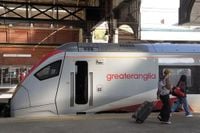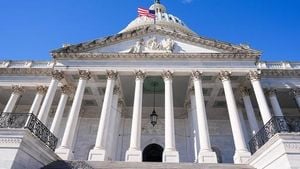On Sunday, October 12, 2025, Greater Anglia officially joined the ranks of publicly owned train operators in the United Kingdom, marking a significant milestone in the government’s ongoing renationalisation of the rail network. This move, lauded by government officials and union leaders alike, means that half of all rail operators in Britain are now under public control, a transformation that is reshaping the country’s approach to rail travel and public service delivery.
Greater Anglia, a key commuter service connecting cities like Cambridge, Ipswich, Norwich, and Colchester to London Liverpool Street, as well as serving Stansted Airport, Peterborough, Hertford, and numerous smaller lines, has long been a vital artery for the East of England. In the 2024-25 year alone, the operator handled an impressive 81.8 million passenger journeys, underscoring its importance to the region’s mobility and economic life, according to BBC reporting.
Transport Secretary Heidi Alexander, who visited Norwich railway station ahead of the transfer, described the renationalisation as a crucial part of the government’s mission to reform a “fragmented system” and lay the groundwork for a “more reliable, efficient and accountable railway.” She emphasized, “Passengers commuting into Norwich or heading for a day out in Cambridge will be travelling on services that are owned by the public, and run with their interests front of mind.” Alexander’s vision is one where the railway “puts passengers first and delivers the high standards they rightly expect.”
This transition is not happening in isolation. Greater Anglia joins a growing family of publicly owned operators, including c2c, Northern, TransPennine Express, Southeastern, LNER, and South Western Railway—each now operated by DfT Operator Limited (DFTO) on behalf of the government. The Department for Transport (DfT) has outlined a clear trajectory: West Midlands Trains will transfer back to public ownership on February 1, 2026, followed by Govia Thameslink Railway on May 31, 2026. Chiltern Railways and Great Western Railways are also expected to make the switch soon after, as reported by the PA news agency.
This wave of public ownership is part of a broader overhaul spearheaded by the Labour government, which has made renationalisation a central pillar of its transportation policy. Analysis by the PA news agency found that with Greater Anglia’s transfer, 40% of train journeys in Britain are now on services run by the public sector. By late May 2026, when Govia Thameslink Railway and West Midlands Trains are fully nationalised, that figure will climb to 61%, based on Office of Rail and Road data for journeys made in the year to March 2025.
Greater Anglia’s reputation as one of the country’s best performing operators further strengthens the case for public ownership. In the three months ending June 30, 2025, the company recorded the joint lowest service cancellation rate in the nation—just 1.5%, matching Chiltern Railways. The DfT has stated that Greater Anglia will “continue to thrive” under public ownership and will be “used as a benchmark for other operators.”
The company is also in the midst of a period of growth and modernization. Two new stations are set to open: Beaulieu Park in north Chelmsford this month, and Cambridge South in early 2026. Greater Anglia has also rolled out a new fleet of bi-mode trains, underscoring its commitment to innovation and regional connectivity. According to BBC, these developments are expected to drive regional growth and improve the passenger experience across the Anglia region.
Martin Beable, Greater Anglia’s managing director, sees the move as a chance to build on past successes. “By working more closely with the wider family of publicly owned operators, we can share expertise, drive innovation, and deliver even better journeys for our passengers across the Anglia region,” he said. Beable added, “This transition also brings us one step closer to Great British Railways—a simpler, more unified network that puts passengers at its heart. Together, we can create a railway that drives growth, sustainability, and pride for the communities we serve and right across the UK.”
The renationalisation effort has also been welcomed by railway workers and their unions. Eddie Dempsey, general secretary of the Rail, Maritime and Transport Union (RMT), called Greater Anglia’s return to public ownership “a big step forward towards creating Great British Railways and to unite track and train under a single publicly owned body, benefiting railway workers and passengers alike.” Dempsey highlighted a recent agreement secured by RMT, which saw a wave of insourcing at London Liverpool Street station. “Train presentation, gateline and customer service staff are now directly employed. This ends years of exploitation where outsourced workers, many from BME backgrounds, were left on worse pay and worse conditions. We still have work to do on outsourcing within the company but this is a fantastic start.”
The journey to this point has been shaped by both political will and practical necessity. While the Labour government has made nationalisation a policy priority, the previous Conservative government also brought several operators into public hands due to performance failings, including Northern, TransPennine Express, Southeastern, and LNER. The action with LNER in June 2018 ended a period when all operators in Britain were privately owned, according to PA analysis. Meanwhile, ScotRail and Transport for Wales remain under the control of the Scottish and Welsh governments, respectively.
Ownership of Greater Anglia switched from Transport UK, which continues to operate East Midlands Railway and West Midlands Trains until their planned nationalisation, as well as the Merseyrail concession and London’s bus network. The shift is emblematic of a broader trend towards public control and accountability in the UK’s rail sector.
Looking ahead, the government’s vision is to integrate these publicly owned operators under the umbrella of Great British Railways, creating a unified network that aims to deliver higher standards, greater efficiency, and a renewed sense of public stewardship. The hope is that, by bringing track and train under a single, publicly owned body, the system will be better equipped to serve both passengers and workers, fostering growth, sustainability, and community pride across the country.
For now, passengers commuting into Norwich, planning a day out in Cambridge, or traveling from Essex, Suffolk, or Norfolk to London can expect their journeys to be shaped by this new era of public ownership—one that, if all goes to plan, will put their interests front and center every step of the way.




